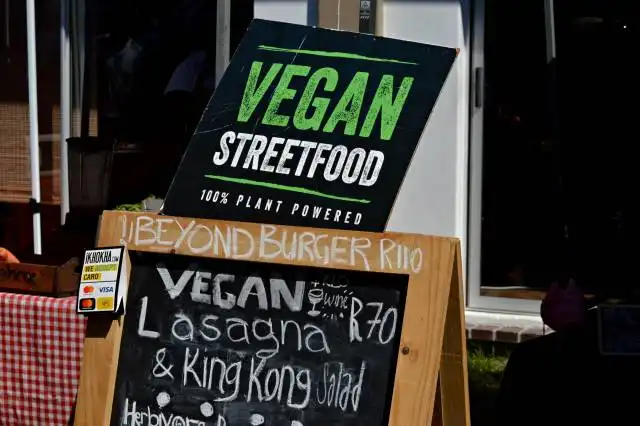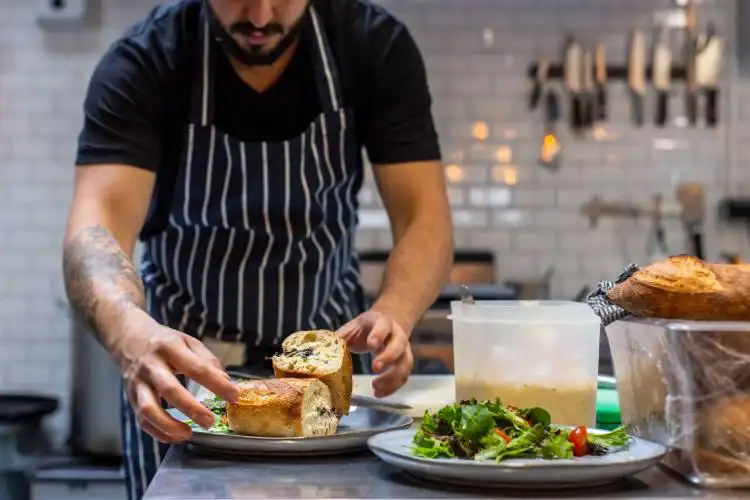Start a Restaurant
Orchestrating a Symphony of Flavors: Your Own Restaurant Story
| Updated


RESTAURANT
Opening a restaurant is like crafting a symphony of flavors, a palatable melody that dances on the taste buds of your clients. It's a venture that feeds not just the belly, but also the soul - after all, good food is good mood, right? This type of business involves planning a unique menu, managing a kitchen, and providing exemplary customer service to create dining experiences that patrons will savor long after the last course. It’s not just about full stomachs, but also about full hearts and repeat customers.
Jump to Business Plan
RELATED BUSINESS IDEAS
Browse ALL Food & Beverage Entrepreneurship Business Ideas
Discover Your Perfect Domain
Unlock the door to your online success with our hand-picked selection of premium domain names. Whether you're starting a new venture or rebranding an existing one, the right domain can set the tone for your digital presence. Browse through our curated list, each with its unique potential to enhance your brand's visibility and credibility.
RESTAURANT MINI BUSINESS PLAN
This a quick reality check to help you identify the strengths and weaknesses of your business concept before you dive in.
Expected Percent Margin:
- Gross Margin: Around 60-70% (restaurants typically mark up dishes by this amount relative to ingredient cost)
- Net Profit Margin: Typically 10-15% in the restaurant industry.
Earnings Expectations:
- Daily Earnings: Varies widely based on location, customer density, and menu pricing. A well-running small to mid-size restaurant might aim for $1500 - $3000 daily.
- Weekly Earnings: $10,500 - $21,000 (assuming 7 operating days)
- Monthly Earnings: $42,000 - $84,000
- Annual Earnings: $500,000 - $1,000,000
Actions to Hit Those Numbers:
Menu Development:
- Unique Proposition: Develop a memorable, high-quality menu with innovative dishes or a unique style.
- Cost Efficiency: Build dishes around cost-effective and versatile ingredients to reduce food waste and operational complexity.
Location and Premises:
- Accessible Location: Situate the restaurant in a high foot traffic area and ensure it is easy to park/arrive at.
- Ambiance: The interior design should be engaging and consistent with the restaurant's brand.
Marketing and Customer Acquisition:
- Social Media Marketing: Regular updates on social media about specials or events can increase visibility to potential customers.
- Local Community Engagement: Collaborating with local events or community activities augments recognition and builds a loyal client base.
Staffing:
- High-quality Chefs: Securing skilled chefs and giving them creative freedom can result in an outstanding menu that attracts customers.
- Well-trained Staff: All restaurant staff should be trained to provide an exceptional customer experience, which will drive repeat patronage.
Financial Management:
- Regular Financial Analysis: Regularly review income, expenses, and profit margins to identify any issues or areas of potential growth.
- Effective Tax Planning: Engage a tax consultant to ensure you are using all possibilities to reduce your tax burden and maintain compliance.
Please note that these figures are generic and could vary greatly depending on the specifics of the restaurant operation, location, cuisine, and competitive environment.
NOT WHAT YOU HAD IN MIND? Here are more ideas



Browse ALL Food & Beverage Entrepreneurship Business Ideas
Grab Your Business Website Name
Before you get caught up in the whirlwind of setting up your business, invest in a domain name. It's a small but significant step that lays the foundation for your brand and makes it easier for customers to find and trust you. Just like you wouldn't build a house without securing the land first, don't build a business without securing your domain name.
"Why? Can't that wait?" Here's why it shouldn't
Step 1: Determine if the Business is Right for You
Breakdown of Startup Expenses
Before starting a restaurant, it is important to understand the financial costs associated with the endeavor. This includes the cost of purchasing or renting a space, purchasing equipment, hiring staff, and obtaining necessary permits and licenses. It is also important to consider the cost of marketing materials, such as menus and signage. Additionally, it is important to consider the cost of any necessary renovations or repairs to the space. Finally, it is important to consider the cost of any necessary insurance policies.
Breakdown of Ongoing Expenses
Once the restaurant is up and running, there are ongoing expenses to consider. This includes the cost of food, beverages, and other supplies. It also includes the cost of staff wages and benefits, as well as the cost of utilities, such as electricity, water, and gas. Additionally, it is important to consider the cost of marketing and advertising, as well as the cost of any necessary repairs or maintenance. Finally, it is important to consider the cost of any necessary insurance policies.
Examples of Ways to Make Money
There are several ways to make money in the restaurant business. This includes charging for meals and beverages, as well as offering catering services. Additionally, it is possible to make money through the sale of merchandise, such as t-shirts or hats. It is also possible to make money through the sale of gift cards or loyalty programs. Finally, it is possible to make money through the sale of alcohol or other beverages.
Step 2: Name the Business
Naming a business is an important step in the process of starting a restaurant. It is important to choose a name that is memorable, unique, and relevant to the type of restaurant being opened. Additionally, it is important to make sure the name is not already taken by another business. To ensure this, it is important to do a trademark search to make sure the name is not already taken. It is also important to make sure the name is not too long or difficult to pronounce. Additionally, it is important to make sure the name is not offensive or inappropriate.
When choosing a name, it is important to consider the type of restaurant being opened and the target audience. For example, a restaurant serving Italian food may want to include the word “Italian” in the name. Additionally, a restaurant targeting a younger demographic may want to choose a name that is more modern and hip. It is also important to consider the location of the restaurant when choosing a name. For example, a restaurant located in a beach town may want to include the word “beach” in the name.
Finally, it is important to consider the potential for branding when choosing a name. A memorable and unique name can help a business stand out from the competition and create a strong brand identity. Additionally, a unique name can help a business create a memorable logo or slogan. A good name can also help a business create a strong online presence and help customers easily find the business online.
Step 3: Secure Financing
When it comes to financing a restaurant, there are several options available. The most common option is to secure a loan from a bank or other financial institution. This option requires a good credit score and a solid business plan. Additionally, the loan must be secured with collateral, such as real estate or other assets. Other options for financing include angel investors, venture capitalists, and crowdfunding. Angel investors and venture capitalists are typically interested in investing in businesses with high growth potential. Crowdfunding is a great option for businesses that are looking to raise money from a large group of people.
Develop a Budget
Once the financing is secured, it is important to develop a budget. This budget should include all of the startup costs, such as equipment, supplies, and rent. It should also include ongoing expenses such as payroll, utilities, and marketing. Additionally, the budget should include a breakdown of projected revenue and expenses. This will help the business owner to determine if the business is viable and if it can be profitable.
Establish a Line of Credit
In addition to securing financing, it is important to establish a line of credit. This line of credit will provide the business with additional funds in case of an emergency or unexpected expenses. It is important to shop around for the best rates and terms. Additionally, it is important to make sure that the line of credit is paid off on time in order to maintain a good credit score.
Create a Business Plan
Finally, it is important to create a business plan. This plan should include a detailed description of the business, the target market, the competitive landscape, and the financial projections. Additionally, the plan should include a marketing strategy and a timeline for achieving the goals. This plan will be used to secure financing and to guide the business in the right direction.
Step 4: Choose a Location
When choosing a location for a restaurant, there are a few important factors to consider. First, the location should be easily accessible to customers and have plenty of parking. Second, the location should be in an area with a high foot traffic and visibility. Third, the location should be in an area with a favorable demographic for the type of restaurant being opened. Fourth, the location should be in an area with reasonable rent and other costs associated with the space.
Researching the Local Competition
Once a potential location has been identified, it is important to research the local competition. This includes researching the types of restaurants in the area, the prices they charge, and the quality of their food. Additionally, it is important to research the local zoning laws and regulations to ensure the restaurant is in compliance. Finally, it is important to research the local customer base to ensure there is enough demand for the restaurant.
Step 5: Design the Restaurant
Designing a restaurant is an important step in the process of starting a restaurant. The elements of designing a restaurant include the layout of the restaurant, the décor, the furniture, and the equipment. It is important to create a space that is inviting and comfortable for customers.
Layout
The layout of the restaurant is the first step in designing the restaurant. It is important to consider the size of the restaurant, the number of tables and chairs, and the flow of the space. It is also important to consider the placement of the kitchen and the bar, if applicable. Additionally, it is important to consider the placement of the bathrooms and the entrance and exit points.
Décor
The décor of the restaurant is the second step in designing the restaurant. It is important to consider the style and atmosphere of the restaurant. It is important to choose colors, artwork, and furniture that create a cohesive atmosphere. Additionally, it is important to consider the lighting of the restaurant and the placement of plants and other decorations.
Furniture
The furniture of the restaurant is the third step in designing the restaurant. It is important to choose furniture that is comfortable and durable. Additionally, it is important to consider the size of the furniture and the number of chairs and tables needed. It is also important to consider the placement of the furniture in the restaurant.
Equipment
The equipment of the restaurant is the fourth step in designing the restaurant. It is important to consider the type of equipment needed for the restaurant. This includes items such as ovens, grills, refrigerators, and dishwashers. Additionally, it is important to consider the placement of the equipment in the restaurant.
Step 6: Obtain Licenses and Permits
When starting a restaurant, there are a variety of licenses and permits that must be obtained in order to legally operate. These can include a food service license, a liquor license, a health permit, and a business license. Depending on the type of restaurant, additional licenses may be required. For example, if the restaurant is serving alcohol, a liquor license will be necessary. Additionally, if the restaurant is serving food, a health permit will be required. It is important to research the local laws and regulations to determine what licenses and permits are needed.
How to Obtain Licenses and Permits
Once the necessary licenses and permits have been identified, the next step is to obtain them. This can be done by contacting the local government office or by visiting the website of the appropriate agency. The process for obtaining a license or permit varies by location, but typically involves submitting an application and paying a fee. Additionally, some licenses and permits may require additional documentation, such as proof of insurance. It is important to ensure that all required documentation is submitted and that the fees are paid in order to avoid any delays in the process.
Cost of Licenses and Permits
The cost of licenses and permits varies depending on the type of license or permit and the location. Generally, the cost of a food service license is relatively low, while the cost of a liquor license can be quite high. Additionally, some locations may require additional fees for inspections or other services. It is important to research the cost of the necessary licenses and permits before starting the process in order to ensure that the costs are within the budget.
Timeframe for Obtaining Licenses and Permits
The timeframe for obtaining licenses and permits also varies depending on the type of license or permit and the location. Generally, the process can take anywhere from a few weeks to several months. It is important to plan ahead and start the process as soon as possible in order to ensure that the necessary licenses and permits are obtained in a timely manner.
Step 7: Hire Employees
When it comes to hiring employees, it is important to make sure you are hiring the right people for the job. Start by creating a job description that outlines the duties and responsibilities of the position. This will help you to narrow down the list of potential employees. Additionally, you should create a list of qualifications and skills that you are looking for in an employee. This will help you to weed out any applicants who do not meet your criteria.
When interviewing potential employees, it is important to ask questions that will help you to determine if the applicant is the right fit for the job. Ask questions about their experience, their qualifications, and their skills. Additionally, you should ask questions about their availability and their ability to work in a team environment.
It is also important to remember to check references. This will help you to get a better understanding of the applicant’s work ethic and their ability to work in a team environment. Additionally, you should consider conducting background checks to ensure that the applicant is trustworthy and reliable.
Finally, it is important to create a fair and competitive compensation package. This will help to attract the best talent and ensure that you are able to retain your employees. Make sure to include benefits such as health insurance, vacation time, and other perks. Additionally, you should consider offering bonuses or incentives to employees who go above and beyond in their duties.
Step 8: Purchase Supplies
When purchasing supplies for a restaurant, it is important to purchase the highest quality supplies that fit within the budget. It is also important to purchase supplies that are durable and easy to maintain. Additionally, it is important to purchase supplies that are energy efficient. This will help to reduce energy costs over time.
When purchasing supplies, it is important to consider the size of the restaurant and the number of customers that will be served. This will help to determine the amount of supplies that will be needed. Additionally, it is important to purchase supplies that are easy to store and transport. This will help to reduce the amount of time spent on restocking and organizing supplies.
It is also important to consider the type of supplies that will be needed. This includes items such as kitchen equipment, furniture, and decorations. Additionally, it is important to purchase supplies that are easy to clean and maintain. This will help to reduce the amount of time spent on cleaning and maintenance.
Finally, it is important to compare prices when purchasing supplies. This will help to ensure that the supplies are purchased at the lowest possible price. Additionally, it is important to purchase supplies from reputable suppliers. This will help to ensure that the supplies are of the highest quality.
Step 9: Market the Restaurant
When it comes to marketing the restaurant, there are a variety of ways to do so. Social media is a great way to get the word out about the restaurant. Creating a website and using platforms such as Facebook, Instagram, and Twitter can help spread the word about the restaurant and its offerings. Additionally, creating a loyalty program or offering discounts to customers can help bring in more business. Additionally, creating a newsletter or offering coupons can help keep customers informed and engaged. Finally, creating partnerships with local businesses or organizations can help increase the restaurant’s visibility and reach.
Tips for Effective Marketing
When it comes to marketing the restaurant, it is important to create a plan. This plan should include a budget, a timeline, and a list of goals. Additionally, it is important to be consistent with the messaging and branding of the restaurant. This means that the same logo, colors, and message should be used across all platforms. Additionally, it is important to be creative and think outside the box when it comes to marketing the restaurant. Finally, it is important to track the success of the marketing efforts to ensure that the restaurant is reaching its desired audience.
EXPLORE MORE CATEGORIES
Browse ALL Business Idea Categories
TAKE THE NEXT STEPS









